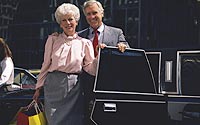
Will an advertisement in a boating magazine for high-end cookware find an audience, or does the ad have to be for Top-Siders, nautical watches
and rain-gear to resonate?
Research firm Ipsos Mendelsohn has taken a look at its own data from last year's media study of affluent consumers, and applied it to the question of endemic
and non-endemic advertising. The resulting 2012 white paper finds validity in so-called non-endemic advertising, where a marketer pitches a product in a medium whose content deals with a completely
different passion point (e.g., cookware in a boating book). Non-endemic ads, because they assume that cross-pollination will happen, rely on relationships between interests across spending categories.
And the firm says the key is finding the right match.
advertisement
advertisement
The data come from last year's Ipsos Mendelsohn Affluent Survey of people 18 and over living in households with at least $100,000 in
annual household income of which there are roughly 58.5 million in the United States, constituting 21% of U.S. households. (Affluents account for about 70% of U.S. net worth, about 60% of U.S. income,
and a majority of consumer spending in many categories, per Ipsos Mendelsohn.)
Says the study, "Ultimately, success with non-endemic advertising requires resonating with the softer elements of
affluent consumers’ psyches — their aspirations, ideals, and values — that underlie their brand preferences." And the firm says non-endemic relationships increase in proportion to an
affluent consumer’s passion for the subject, whether TV, print or other media. "Non-endemic advertising is less about appealing to the casual consumer, and more about connecting with enthusiasts
(who, by the way, continue to spend on their passions even when they cut back in other categories)," says the study.
As an example, the study found that affluent Americans who skied last year
spent five times more in the endemic category than all of the affluents surveyed. They spent 50% more on sporting-related categories like bicycling, tennis racquets and golf equipment and 20% to 50%
more on purely non-endemic categories like dining, watches, jewelry, organic food, home decor, tablets and e-readers.
When it comes to football, which along with baseball and basketball is one
of the top three sports among affluents, enthusiasm matches the value of certain non-endemic categories. The report says that as enthusiasm for football rises, so does the average spend on
entertainment, and especially event tickets. The same holds for automotive magazines and certain non-endemic product categories. The study finds that as the number of automotive titles on affluent
consumers' reading list increases so does their interest in home improvement, science and technology, finance, appliances, risk taking, consumer news, and electronics. "heavy" readers of
automotive titles (those who read as many as four auto buff books) have a much stronger affinity in those areas.
Affluents who like cuisine and cooking and pursue that interest through
numerous media channels also overindex for home and garden, travel, apparel and accessories, electronics, personal care, and watches and jewelry, per the report. "In addition to owning upscale
household and kitchen appliances, this affluent segment shows a predilection for non-endemic brands such as Estee Lauder, Coach and Ralph Lauren as well as many more consumer brands."